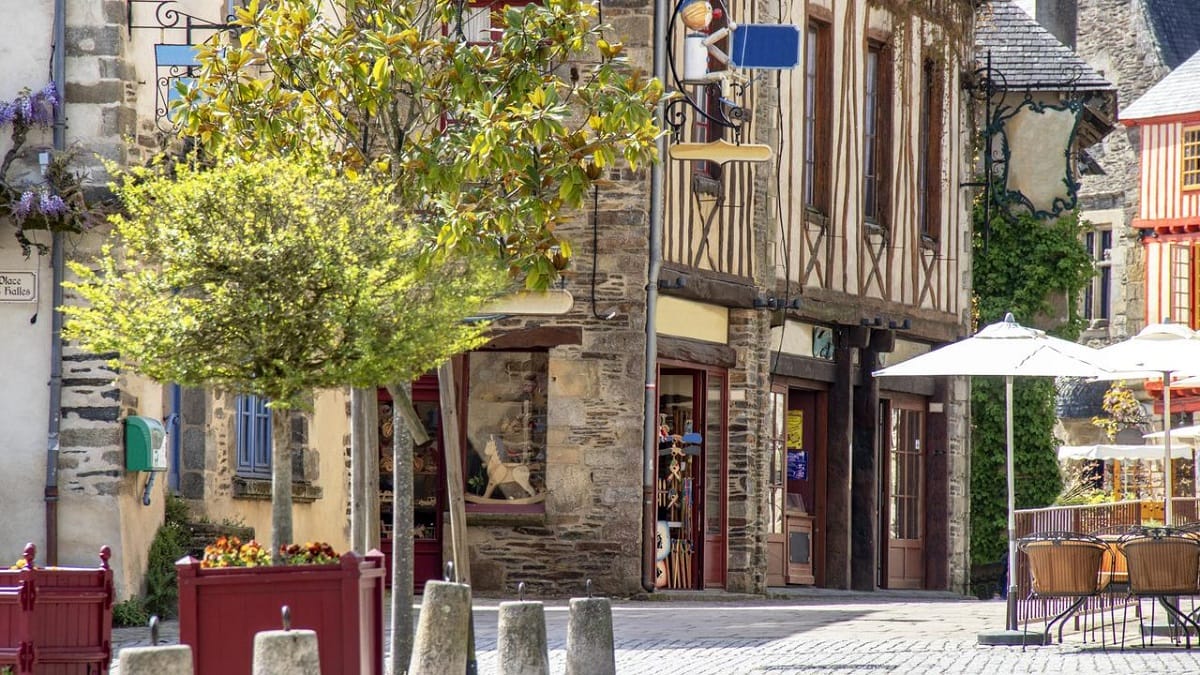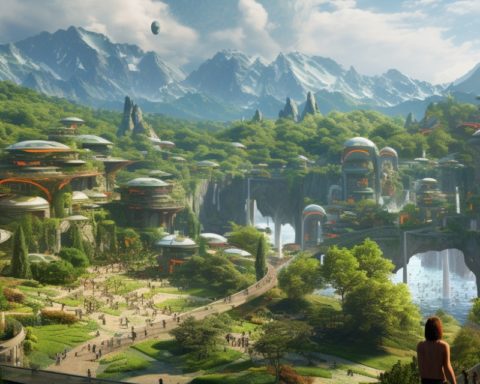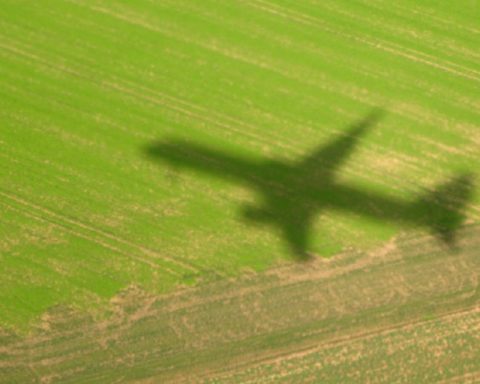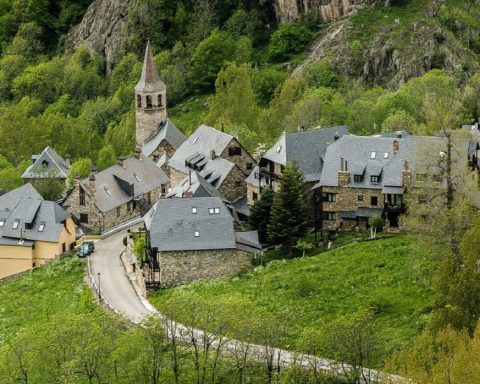The coronavirus crisis shows how fragile the food supply of cities is. Because of this, some basic necessities are missing in some shops in the West, a bit like in the old Soviet Union shops! Developing cities that are more resilient in terms of food, economy and ecology means rethinking town and country planning with a view to relocation. This is why small towns or large villages are the future of future urbanization.
Creating small towns also strengthens democracy. Reducing the distances to supply the municipalities allows both more autonomy and less travel, thus limiting global warming. The amount of land available for cultivation is decreasing with increasing urbanisation. Efficiency consists of cultivating the majority of agricultural land on the outskirts of the city and placing small wooded areas in the city. Slowing down cities is also one of the dimensions of relocation policies.
Ecological urban planning must therefore choose between, among other things: a return to the land towards large villages or the expansion of small towns; urban densification or revegetation; the development of agriculture or forestry; and the establishment of vegetation in or around towns.
- READ UP'. : " Cities are in danger of becoming contamination bombs"
There are experiments to make cities more self-sufficient in terms of food.
Thus, for several years now there has been a growing practice of market gardening in the cities, notably thanks to the movement of the "incredible edible" or "plant guerrillas" ... It is in a way a return to the old allotments. However, in the past it was mainly a food supplement, whereas now it is aimed primarily at greater food autonomy in the cities from a more ecological perspective. According to environmentalist Roland Vidal, this craze can be explained by three sources of concern: 1) "the health quality of foodstuffs" by reducing distances and improving producers' knowledge through greater transparency and social ties, 2) "security of supply", at a time when oil resources are gradually diminishing, and 3) "environmental impact".
However, the current action of these militant movements is only a tiny supplement to the agricultural production imported from the countryside to the cities. For in the big cities, the vast majority of food will still come from the grain and market gardening fields over larger areas far from the cities. For the micro market gardening areas in the city will never be sufficient to feed the entire population of a city. All the more so as the latter finds its coherence and its societal and ecological interest in a minimum density of dwellings. Indeed, according to agronomist Carl Gaigné, to feed a city like Paris with its 2 million inhabitants and 105.40 km², it requires "three million hectares, six times more than the Ile de France region has. So even if we brought the production sites as close as possible to the city, we would still have to travel about 200 to 300 km to feed the entire population of Paris. However, it is thanks to the development of transport and in particular the railways that "the very poorly nourished Parisians in the 19th century ate much better". Consequently, the smaller the cities, the more they reduce their carbon footprint. On the other hand, if they become villages, then they lose their overall autonomy from other services. Unless they return to a peasant way of life with a loss of diversity and quality in terms of industry and services, schools, health, industry, culture, leisure...
Small towns or big villages are the future of urbanization
Through the carbon and ecological footprint, the environmental crisis is leading to an awareness of a new organisation of travel and housing. Yet urban planning choices not only have a practical function, they also contribute to changing the urban and rural landscape.
In traditional communities, social relations were facilitated by the relative size of the villages. However, it could also become relatively suffocating or sclerotic. Thus, the declining population wants the individualistic solitude of the megacities to be replaced by more social relations, through the creation of small towns or large villages.
However, creating a multitude of houses and villages in the countryside is not viable in the long term, as it involves significant travel between villages and/or the nearest town. Only almost complete autonomy, in economic, social or relational terms, would make it possible to avoid excessive travel, which seems rather difficult to envisage at present.
Yet it is estimated that "80% of the work of others consumed by an individual is produced within a radius of 20 km around him". Life is thus in reality largely local, but globalization tends to push us further and further away from it, creating a loss of autonomy and ecological damage. Indeed, in terms of ecological and carbon footprint, excessive travel has a significant cost (oil, CO2, extraction of metals for vehicle production...). It is the same for the idea of having each person's own house with a garden. For these various economic reasons, humanity will gradually seek to minimize the ecological cost of its habitat and its travel, by encouraging the development of large villages or small towns.
The ideal size of a city was 30,000 inhabitants according to Plato. Following him, the young Aristotle, says in Ethics in Nicomaque that "For if ten men cannot form a city, one hundred thousand men cannot form a city," for they can no longer converse among themselves (IX, 9, 1170, b31). The Greek philosopher Takis Fotopoulos takes up this conception and also envisages limiting himself to small towns. For him, it would be a matter of creating a "federation of demoi", i.e. small homogeneous units of about 30,000 inhabitants. According to him, this figure makes it possible to satisfy most of the essential needs locally. Contrary to popular belief, size would not be an "exclusive or even decisive determinant of economic viability". Many modern cities will probably have to be "broken up into several 'demoisons' because of their gigantic size," he says. Below this limit, people can walk across their city without having to take a bus or car; they can get to school, the market, the library or the medical centre in a few minutes. However, on the other hand, "millions of people are starting to move around. Attracted by the lights of the city, they desert the rural areas and go to the big city where they cause pathological growth".
The Garden City is a city similar in size to Plato and Fotopoulos. It is an idea of the British town planner Ebenezer Howard, in his book " To-morrow: A peaceful path to real reform "of 1898. This local democratic utopia is in line with the ideas of most thinkers of an ecological democracy, such as the anarchist Murray Bookchin. « It's not totally absurd...writes this one, to think that an ecological society could be made up of a municipality of small municipalities, each of which would be formed by a smaller "commune of municipalities" (...) in perfect harmony with their ecosystem. This is in line with the path traced by the 'Slow City' movement, following the Slow Food movement. This is a worldwide network of medium-sized cities that voluntarily limit their population growth to 60,000 inhabitants."
On the other hand, the famous economist Schumacher, author of the best-selling book " Small is beautiful "sets the limit way above! He estimated that 500,000 inhabitants should be an upper limit, beyond which a city is no longer livable.
Since 2009, Siemens and The Economist have created an index of European green cities. Their criteria are not really those of radical environmentalists, since the three cities they have elected the greenest are cities with less than 1 million inhabitants, but with a population ranging from 960,000 inhabitants in Stockholm to 600,000 in Oslo and Copenhagen. By way of comparison, Paris intramural has 2 million inhabitants. On the other hand, this index did not elect cities with more than 1 million inhabitants, as they nevertheless allow "shorter" and "gentler" journeys, such as "walking and cycling". Their evaluation is based on some thirty indicators divided into eight categories: CO2 emissions, energy, buildings, transport, water, waste management, air quality, environmental governance. This index does not take into account the criterion of cultural quality of life, nor professional opportunities, since it focuses solely on the environment. « There is also an even stronger correlation with the level of wealth (...), as they can invest more powerfully in efficient ecological infrastructure "says Julien Damon. On the other hand, if we select only the criterion of carbon footprint or ecological footprint, these three big cities elected as green cities, would not have a good ranking. Especially because of the number of inhabitants. Because this requires the transport of agricultural goods from far away from the city, at least 100 to 150 km away. In addition, too high a population density requires the construction of transport infrastructures for the inhabitants, such as underground railways, which generate a very large carbon and ecological footprint. Too much population density increases infrastructure to excess and thus the ecological footprint. On the other hand, too little density limits economic autonomy, thus pushing towards more travel outside the city, for example to go to work, or for leisure...
In the light of these various indicators, it seems to us that the proposals for limiting the size of cities, which seem the most realistic from an ecological and socio-economic point of view, vary between 30,000 inhabitants (equivalent to the size of the city of Dole in the Jura) and 60,000 inhabitants, such as the cities of Chambéry, Niort or Troyes in 2020. This mode of relocated organisation offers the advantage of allowing socio-economic, but also political (self-management) autonomy and quality of life, due to the proximity of the relationship with nature in particular.
Creating small towns also strengthens democracy
Because in big cities, a small number of elected officials and experts lead a large number of citizens, unlike in small towns. In the latter, the number of elected officials in relation to the number of citizens is smaller, so they have a proportionally greater likelihood of being able to take part in the decisions that affect them. The worst is reached in small villages; however, they lose economic autonomy when they do not reach the minimum size for economic self-sufficiency. They are then dependent on the public, social and economic infrastructure of the larger settlements around them. This is what pushes some villages to become part of communities of communes. But sometimes, it is also the law that obliges them to do so in a perspective of financial economy in the management of small communes.
For Paul Ariès, the greater autonomy of city dwellers also depends on their ability to limit themselves, to reduce hubris and excess. "Slow cities, because they constantly articulate these strategies of relocation and retemporalisation, tend to restore the quality of life, that is to say, to give birth to a more humane human being because he or she is more autonomous, because he or she is the only one capable of self-limitation (...).
The praise of slowness is also that of the time needed for maturation, for doubt, for deliberation, for choice. The inhabitants of slow cities are therefore reflecting on the temporality necessary for the respect of democracy: it is already necessary to put an end to the unlimited faith in the coming time that is conveyed, for example, by ambient scientism. Democracy, like education, needs slowness. «
The Cities in Transition initiative aims to develop local self-government through relocation. In this context, the "Cities in Transition" initiative is being developed to develop local self-government through relocation. It was born in 2005 in Totnes, a town of 9,000 inhabitants in the south-west of England, and has spread rapidly throughout the world. In 2010 in Ferney-Votaire, in the Ain department near Geneva, a local initiative of "Cities in Transition" was created. "The members organized themselves into several groups around the issues of "waste, recycling, repair" and "synergistic vegetable garden". Thus, they put their ideas into practice and organize debates in their city on these two themes. The association "le potager synergique" (the synergistic vegetable garden) has set itself the goal of relocating food and greening cities.
Arable land is shrinking with increasing urbanisation
Against the increasingly rapid disappearance of agricultural land linked to urbanization (housing, commercial areas, roads, parking ...) a "national campaign for the creation, preservation and extension of food belts around urban areas" was launched in 2011 by the association ".... Relocate« . Because "54,000 hectares of farmland disappear every year in France: the equivalent of a department is swallowed up by tar and concrete every 7 years. These lands are replaced, at 50%, by individual houses and at nearly 20%, by the development of the road network, accompanying this expansion. In addition, there is an airport here, a logistics platform for mass distribution, a commercial zone, etc. The number of farms has thus been halved in twenty years, while their average surface area has almost doubled (42 to 77 ha).
This mode of relocated organisation offers the advantage of allowing socio-economic, but also political (self-management) autonomy and quality of life, due to the proximity of the relationship to nature in particular.
Is the return to the land consistent with the relocation?
Since 1968, there has been a return to the land of the city-dwellers. After a pause in the 1980s, this movement has been picking up again since the 2000s. People who make this choice do not only go there to live, but also to work as peasants (rather than farmers). The latter sometimes try to develop Amap or local sales, in order to develop short circuits, which are part of a relocation objective. But how can the return to the land (which means moving away from the cities) and short circuits in the cities in particular be articulated, which implies developing agriculture on land fairly close to the cities? There is indeed a twofold antagonistic movement, but one that can be resolved if these new farmers do not leave to farm too far from the cities. However, they often lack available land.
One of the solutions for relocating agricultural food production is therefore to return to the land, in particular to develop local agriculture, also by increasing the number of farmers. Another possible solution for relocating agricultural food production is the development of small towns around new land to be cultivated by new farmers in sufficient numbers. However, the growth in the number of inhabitants in large villages nevertheless contributes to increased displacement. In this case, the growth of rural dwellers contributes to increasing the dispersion of the habitat and thus the distance of displacement. This is detrimental to relocation and thus to the carbon and ecological footprint.
It is therefore necessary to take into account the quantity of inhabitants in the large villages, the surface area of the villages, but especially the density of inhabitants per km². It is therefore not the fact of living in a large village, rather than in a large city, that proves to be the key criterion for relocation, but the criterion of autonomy and the density of inhabitants per km² of these villages. If the latter turn out to be too small in terms of number of inhabitants, they do not prove to be economically self-sufficient. As a result, travel to work and shopping increases. If the number of inhabitants proves to be sufficient to expect autonomy, but the size of the villages proves to be large in surface area, while there is not enough density per km², travel within the village also increases.
In fact, returning to the land is ecologically beneficial if the ecological footprint of new rural villages is no greater than that of densified cities. To achieve this, the villages must therefore be mostly autonomous economically, but also culturally (leisure activities, associations, shows, etc.), so that they are no longer forced to systematically use their vehicles. This orientation proves to be beneficial to the development of agricultural alternatives consisting in the development of small, more labour-intensive agricultural properties that produce in a less polluting and more biological way.
There are therefore three ecologically unsustainable directions: 1) Ugly, polluted and insufficiently dense gigantic cities, such as Los Angeles, with long and ecologically harmful transport times. 2) Or, conversely, urban mega-cities, such as Paris, so dense that their carbon and ecological footprint is unsustainable, particularly because of the cost of public transport infrastructure, such as subways. 3) The third solution is not sustainable either, that of returning to the land and developing too small, non-autonomous villages that are too distant from each other or from large cities.
Contrary to these three directions, there are two coherent orientations that could develop simultaneously: 1) The return to the land around large autonomous villages or 2) small autonomous towns producing, in economically short circuits, towns that are dense, diversified, beautiful and vegetated.
Efficiency consists of cultivating the majority of agricultural land on the outskirts of the city and placing small wooded areas in the city.
It is the most efficient way to manage travel in the city, while maintaining an environment based on the beauty of nature. In fact, while growing crops in the city reduces the distance between the producer and the consumer, thus reducing CO2 emissions, on the other hand, it increases the perimeter of the city, thus increasing the time and distance of travel within it and therefore the CO2 emissions or the expenditure of electrical energy. However, the amount of travel by city dwellers is greater than that of farmers, mainly because there are fewer of them. It is therefore better for farmers to place their land on the outskirts of towns and not in the cities. This does not prevent a few citizens who are environmental activists from sowing micro-spaces of land between two roads or two sidewalks, with the aim of greening the city, developing local food and reclaiming fallow land for food. It also has the virtues of raising the awareness of city dwellers, with an educational and militant aim. In addition, it helps to raise public awareness of ecological and agricultural issues related to urban planning and transport. In this perspective, there is for example the "food for thought" movement. incredible edible "The aim is to share the product of their culture, in a perspective of gratuity and therefore solidarity.
However, if the reduction in the transport of products from the fields, which are far from the cities, reduces CO2, it also reduces food diversity, since it is more difficult to eat non-local products. For Parisians, this means depriving themselves of "tomatoes from Marmande, melons from Cavaillon, apricots from Roussillon" warns environmentalist Roland Vidal. He therefore prefers instead to "increase the energy efficiency of a product", measured through "life cycle analysis". It is "an evaluation process by which we measure all the environmental impacts of a product. He adds that energy efficiency in transportation should also be increased in order to reduce CO2 emissions. The latter should not be avoided. However, supporters of eco-solidarity relocation place priority on "locavorism", i.e. locally grown food, in the calculation of the carbon and ecological footprint, but also for reasons of economic and democratic autonomy.
In addition, cities that are too big generate too much travel. Damon explains that this leads to inequalities between the richest or most educated inhabitants, who may live in or near the centre, and the poorest. That is, unskilled or less educated labour, such as maintenance staff, or secretaries, who are forced to live on the outskirts because of the prohibitive cost of rents or the price per square metre. « The social challenge is to allow different inhabitants to live together. " Damon just pointed out. The growth in the size of cities increases travel, thus CO2 emissions, the drudgery of work and social inequalities. So there is a constant wage race between cities to attract the most competent staff. This increases inequality even further. In the same way, the social mix of neighbourhoods between social classes is a challenge for cities.
Slowing down cities is therefore one of the dimensions of relocation policies. From this perspective, it is more rational to place agricultural areas and non-agricultural vegetation on the outskirts of the city. This is one of the concrete issues that arise in policies of densification from an ecological perspective, of public transport, but also of societal intensity .
A balance must be struck between the development of urban density and the greening of cities. For this, it is more rational to place mainly agricultural land around the city and not in the city. This does not prevent a little market gardening by planting a few vegetables, in micro-surfaces, private or collective gardens, around trees and parks located in the city. However, urban forest parks are preferable, as they better guarantee a vegetal urban aesthetic, a factor of quality of life.














This is a very interesting analysis, but it seems to me that the economic factor is somewhat underestimated. In order to avoid travel and ensure the economic revenues of a city, a number of businesses must thrive there. However, it often happens that an average town of a few tens of thousands of inhabitants too often depends on the activity of a single company (St-Nazaire with the shipyards, Roubaix with La Redoute) which, for its part, does not have an exclusively local vocation. In the event of the latter's difficulties, it is the whole town in question that suffers. In addition, these companies sometimes exercise political or economic influence.… Read more "